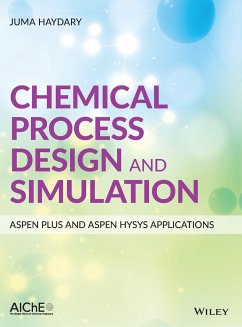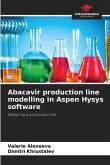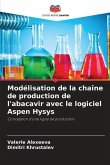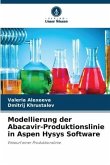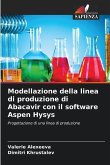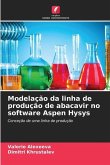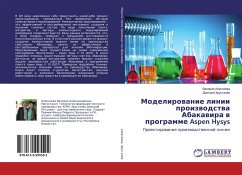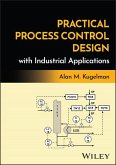Juma Haydary
Chemical Process Design and Simulation: Aspen Plus and Aspen Hysys Applications
Juma Haydary
Chemical Process Design and Simulation: Aspen Plus and Aspen Hysys Applications
- Gebundenes Buch
- Merkliste
- Auf die Merkliste
- Bewerten Bewerten
- Teilen
- Produkt teilen
- Produkterinnerung
- Produkterinnerung
A comprehensive and example oriented text for the study of chemical process design and simulation Chemical Process Design and Simulation is an accessible guide that offers information on the most important principles of chemical engineering design and includes illustrative examples of their application that uses simulation software. A comprehensive and practical resource, the text uses both Aspen Plus and Aspen Hysys simulation software. The author describes the basic methodologies for computer aided design and offers a description of the basic steps of process simulation in Aspen Plus and…mehr
Andere Kunden interessierten sich auch für
![Abacavir production line modelling in Aspen Hysys software Abacavir production line modelling in Aspen Hysys software]() Valerie AlexeevaAbacavir production line modelling in Aspen Hysys software22,99 €
Valerie AlexeevaAbacavir production line modelling in Aspen Hysys software22,99 €![Modélisation de la chaîne de production de l'abacavir avec le logiciel Aspen Hysys Modélisation de la chaîne de production de l'abacavir avec le logiciel Aspen Hysys]() Valerie AlexeevaModélisation de la chaîne de production de l'abacavir avec le logiciel Aspen Hysys22,99 €
Valerie AlexeevaModélisation de la chaîne de production de l'abacavir avec le logiciel Aspen Hysys22,99 €![Modellierung der Abacavir-Produktionslinie in Aspen Hysys Software Modellierung der Abacavir-Produktionslinie in Aspen Hysys Software]() Valeria AlexeevaModellierung der Abacavir-Produktionslinie in Aspen Hysys Software32,90 €
Valeria AlexeevaModellierung der Abacavir-Produktionslinie in Aspen Hysys Software32,90 €![Modellazione della linea di produzione di Abacavir con il software Aspen Hysys Modellazione della linea di produzione di Abacavir con il software Aspen Hysys]() Valerie AlexeevaModellazione della linea di produzione di Abacavir con il software Aspen Hysys22,99 €
Valerie AlexeevaModellazione della linea di produzione di Abacavir con il software Aspen Hysys22,99 €![Modelação da linha de produção de abacavir no software Aspen Hysys Modelação da linha de produção de abacavir no software Aspen Hysys]() Valerie AlexeevaModelação da linha de produção de abacavir no software Aspen Hysys22,99 €
Valerie AlexeevaModelação da linha de produção de abacavir no software Aspen Hysys22,99 €![Modelirowanie linii proizwodstwa Abakawira w programme Aspen Hysys Modelirowanie linii proizwodstwa Abakawira w programme Aspen Hysys]() Valeriq AlexeewaModelirowanie linii proizwodstwa Abakawira w programme Aspen Hysys22,99 €
Valeriq AlexeewaModelirowanie linii proizwodstwa Abakawira w programme Aspen Hysys22,99 €![Practical Process Control Design with Industrial Applications Practical Process Control Design with Industrial Applications]() Alan M KugelmanPractical Process Control Design with Industrial Applications201,99 €
Alan M KugelmanPractical Process Control Design with Industrial Applications201,99 €-
-
-
A comprehensive and example oriented text for the study of chemical process design and simulation Chemical Process Design and Simulation is an accessible guide that offers information on the most important principles of chemical engineering design and includes illustrative examples of their application that uses simulation software. A comprehensive and practical resource, the text uses both Aspen Plus and Aspen Hysys simulation software. The author describes the basic methodologies for computer aided design and offers a description of the basic steps of process simulation in Aspen Plus and Aspen Hysys. The text reviews the design and simulation of individual simple unit operations that includes a mathematical model of each unit operation such as reactors, separators, and heat exchangers. The author also explores the design of new plants and simulation of existing plants where conventional chemicals and material mixtures with measurable compositions are used. In addition, to aid in comprehension, solutions to examples of real problems are included. The final section covers plant design and simulation of processes using nonconventional components. This important resource: * Includes information on the application of both the Aspen Plus and Aspen Hysys software that enables a comparison of the two software systems * Combines the basic theoretical principles of chemical process and design with real-world examples * Covers both processes with conventional organic chemicals and processes with more complex materials such as solids, oil blends, polymers and electrolytes * Presents examples that are solved using a new version of Aspen software, ASPEN One 9 Written for students and academics in the field of process design, Chemical Process Design and Simulation is a practical and accessible guide to the chemical process design and simulation using proven software.
Hinweis: Dieser Artikel kann nur an eine deutsche Lieferadresse ausgeliefert werden.
Hinweis: Dieser Artikel kann nur an eine deutsche Lieferadresse ausgeliefert werden.
Produktdetails
- Produktdetails
- Verlag: Wiley
- Seitenzahl: 448
- Erscheinungstermin: 23. Januar 2019
- Englisch
- Abmessung: 286mm x 221mm x 28mm
- Gewicht: 1352g
- ISBN-13: 9781119089117
- ISBN-10: 1119089115
- Artikelnr.: 50108316
- Herstellerkennzeichnung
- Libri GmbH
- Europaallee 1
- 36244 Bad Hersfeld
- gpsr@libri.de
- Verlag: Wiley
- Seitenzahl: 448
- Erscheinungstermin: 23. Januar 2019
- Englisch
- Abmessung: 286mm x 221mm x 28mm
- Gewicht: 1352g
- ISBN-13: 9781119089117
- ISBN-10: 1119089115
- Artikelnr.: 50108316
- Herstellerkennzeichnung
- Libri GmbH
- Europaallee 1
- 36244 Bad Hersfeld
- gpsr@libri.de
JUMA HAYDARY is a Faculty member of Chemical and Food Technology in the Department of Chemical and Biochemical Engineering at Slovak University of Technology in Bratislava.
List of Tables xiii
List of Figures xvii
About the author xxv
Preface xxvii
Acknowledgments xxix
Abbreviations xxxi
Symbols xxxiii
About the Companion Website xliii
Part I Introduction to Design and Simulation 1
1 Introduction to Computer-Aided Process Design and Simulation 3
1.1 Process Design 3
1.2 Process Chemistry Concept 4
1.3 Technology Concept 5
1.4 Data Collection 6
1.4.1 Material Properties Data 6
1.4.2 Phase Equilibrium Data 6
1.4.3 Reaction Equilibrium and Reaction Kinetic Data 6
1.5 Simulation of an Existing Process 6
1.6 Development of Process Flow Diagrams 7
1.7 Process Simulation Programs 7
1.7.1 SequentialModular versus Equation-Oriented Approach 9
1.7.2 Starting a Simulation with Aspen Plus 10
1.7.3 Starting a Simulation with Aspen HYSYS 11
1.8 Conventional versus Nonconventional Components 11
1.9 Process Integration and Energy Analysis 14
1.10 Process Economic Evaluation 14
References 14
2 General Procedure for Process Simulation 15
2.1 Component Selection 15
2.2 Property Methods and Phase Equilibrium 25
2.2.1 Physical Property Data Sources 25
2.2.2 Phase Equilibrium Models 27
2.2.3 Selection of a Property Method in Aspen Plus 31
2.2.4 Selection of a Property Package in Aspen HYSYS 35
2.2.5 Pure Component Property Analysis 36
2.2.6 Binary Analysis 38
2.2.7 Azeotrope Search and Analysis of Ternary Systems 44
2.2.8 PT Envelope Analysis 47
2.3 Chemistry and Reactions 48
2.4 Process Flow Diagrams 53
References 58
Part II Design and Simulation of Single Unit Operations 61
3 Heat Exchangers 63
3.1 Heater and Cooler Models 63
3.2 Simple Heat Exchanger Models 66
3.3 Simple Design and Rating of Heat Exchangers 69
3.4 Detailed Design and Simulation of Heat Exchangers 72
3.4.1 HYSYS Dynamic Rating 74
3.4.2 Rigorous Shell and Tube Heat Exchanger Design Using EDR 76
3.5 Selection and Costing of Heat Exchangers 77
References 82
4 Pressure Changing Equipment 85
4.1 Pumps, Hydraulic Turbines, and Valves 85
4.2 Compressors and Gas Turbines 88
4.3 Pressure Drop Calculations in Pipes 92
4.4 Selection and Costing of Pressure Changing Equipment 97
References 99
5 Reactors 101
5.1 Material and Enthalpy Balance of a Chemical Reactor 101
5.2 Stoichiometry and Yield Reactor Models 101
5.3 Chemical Equilibrium Reactor Models 106
5.3.1 REquil Model of Aspen Plus 108
5.3.2 Equilibrium Reactor Model of Aspen HYSYS 108
5.3.3 RGibbs Model of Aspen Plus and Gibbs Reactor Model of Aspen HYSYS 109
5.4 Kinetic Reactor Models 110
5.5 Selection and Costing of Chemical Reactors 122
References 124
6 Separation Equipment 125
6.1 Single Contact Phase Separation 125
6.2 Distillation Column 127
6.2.1 Shortcut DistillationMethod 128
6.2.2 Rigorous Methods 131
6.3 Azeotropic and Extractive Distillation 136
6.4 Reactive Distillation 141
6.5 Absorption and Desorption 145
6.6 Extraction 148
6.7 Selection and Costing of Separation Equipment 150
6.7.1 Distillation Equipment 150
6.7.2 Absorption Equipment 151
6.7.3 Extraction Equipment 152
References 153
7 Solid Handling 155
7.1 Dryer 155
7.2 Crystallizer 160
7.3 Filter 162
7.4 Cyclone 163
7.5 Selection and Costing of Solid Handling Equipment 166
References 167
Exercises - Part II 168
Part III Plant Design and Simulation: Conventional Components 173
8 Simple Concept Design of a New Process 175
8.1 Analysis of Materials and Chemical Reactions 175
8.1.1 Ethyl Acetate Process 175
8.1.2 Styrene Process 176
8.2 Selection of Technology 176
8.2.1 Ethyl Acetate Process 176
8.2.2 Styrene Process 177
8.3 Data Analysis 180
8.3.1 Pure Component Property Analysis 180
8.3.2 Reaction Kinetic and Equilibrium Data 181
8.3.3 Phase Equilibrium Data 185
8.4 Starting Aspen Simulation 188
8.4.1 Ethyl Acetate Process 188
8.4.2 Styrene Process 188
8.5 Process Flow Diagram and Preliminary Simulation 188
8.5.1 Ethyl Acetate Process 188
8.5.2 Styrene Process 193
References 200
9 Process Simulation in an Existing Plant 203
9.1 Analysis of Process Scheme and Syntheses of a Simulation Scheme 203
9.2 Obtaining Input Data from the Records of Process Operation and
Technological Documentation 205
9.3 Property Method Selection 206
9.4 Simulator Flow Diagram 207
9.5 Simulation Results 208
9.6 Results Evaluation and Comparison with Real-Data Recorded 208
9.7 Scenarios for Suggested Changes and Their Simulation 211
References 214
10 Material Integration 215
10.1 Material Recycling Strategy 215
10.2 Material Recycling in Aspen Plus 216
10.3 Material Recycling in Aspen HYSYS 219
10.4 Recycling Ratio Optimization 223
10.5 Steam Requirement Simulation 230
10.6 CoolingWater and Other Coolants Requirement Simulation 232
10.7 Gas Fuel Requirement Simulation 233
References 237
11 Energy Integration 239
11.1 Energy Recovery Simulation by Aspen Plus 239
11.2 Energy Recovery Simulation in Aspen HYSYS 242
11.3 Waste Stream Combustion Simulation 244
11.4 Heat Pump Simulation 250
11.5 Heat Exchanger Networks and Energy Analysis Tools in Aspen Software
253
References 261
12 Economic Evaluation 263
12.1 Estimation of Capital Costs 263
12.2 Estimation of Operating Costs 266
12.2.1 Raw Materials 267
12.2.2 Utilities 268
12.2.3 Operating Labor 269
12.2.4 Other Manufacturing Costs 270
12.2.5 General Expenses 270
12.3 Analysis of Profitability 270
12.4 Economic Evaluation Tools of Aspen Software 274
12.4.1 Economic Evaluation Button 274
12.4.2 Economics Active 275
12.4.3 Detailed Economic Evaluation by APEA 275
References 278
Exercises - Part III 279
Part IV Plant Design and Simulation: Nonconventional Components 283
13 Design and Simulation Using Pseudocomponents 285
13.1 Petroleum Assays and Blends 285
13.1.1 Petroleum Assay Characterization in Aspen HYSYS 286
13.1.2 Petroleum Assay Characterization in Aspen Plus 289
13.2 Primary Distillation of Crude Oil 294
13.3 Cracking and Hydrocracking Processes 307
13.3.1 Hydrocracking of Vacuum Residue 309
13.3.2 Modeling of an FCC Unit in Aspen HYSYS 315
References 319
14 Processes with Nonconventional Solids 321
14.1 Drying of Nonconventional Solids 321
14.2 Combustion of Solid Fuels 326
14.3 Coal, Biomass, and SolidWaste Gasification 329
14.3.1 Chemistry 329
14.3.2 Technology 332
14.3.3 Data 334
14.3.4 Simulation 334
14.4 Pyrolysis of Organic Solids and Bio-oil Upgrading 341
14.4.1 Component List 341
14.4.2 Property Models 342
14.4.3 Process Flow Diagram 342
14.4.4 Feed Stream 344
14.4.5 Pyrolysis Yields 344
14.4.6 Distillation Column 344
14.4.7 Results 344
References 346
15 Processes with Electrolytes 347
15.1 Acid Gas Removal by an Alkali Aqueous Solution 347
15.1.1 Chemistry 347
15.1.2 Property Methods 350
15.1.3 Process Flow Diagram 351
15.1.4 Simulation Results 353
15.2 Simulation of Sour Gas Removal by Aqueous Solution of Amines 355
15.3 Rate-Based Modeling of Absorbers with Electrolytes 361
References 365
16 Simulation of Polymer Production Processes 367
16.1 Overview of Modeling Polymerization Process in Aspen Plus 367
16.2 Component Characterization 368
16.3 Property Method 369
16.4 Reaction Kinetics 370
16.5 Process Flow Diagram 375
16.6 Results 379
References 383
Exercises - Part IV 384
Index 387
List of Figures xvii
About the author xxv
Preface xxvii
Acknowledgments xxix
Abbreviations xxxi
Symbols xxxiii
About the Companion Website xliii
Part I Introduction to Design and Simulation 1
1 Introduction to Computer-Aided Process Design and Simulation 3
1.1 Process Design 3
1.2 Process Chemistry Concept 4
1.3 Technology Concept 5
1.4 Data Collection 6
1.4.1 Material Properties Data 6
1.4.2 Phase Equilibrium Data 6
1.4.3 Reaction Equilibrium and Reaction Kinetic Data 6
1.5 Simulation of an Existing Process 6
1.6 Development of Process Flow Diagrams 7
1.7 Process Simulation Programs 7
1.7.1 SequentialModular versus Equation-Oriented Approach 9
1.7.2 Starting a Simulation with Aspen Plus 10
1.7.3 Starting a Simulation with Aspen HYSYS 11
1.8 Conventional versus Nonconventional Components 11
1.9 Process Integration and Energy Analysis 14
1.10 Process Economic Evaluation 14
References 14
2 General Procedure for Process Simulation 15
2.1 Component Selection 15
2.2 Property Methods and Phase Equilibrium 25
2.2.1 Physical Property Data Sources 25
2.2.2 Phase Equilibrium Models 27
2.2.3 Selection of a Property Method in Aspen Plus 31
2.2.4 Selection of a Property Package in Aspen HYSYS 35
2.2.5 Pure Component Property Analysis 36
2.2.6 Binary Analysis 38
2.2.7 Azeotrope Search and Analysis of Ternary Systems 44
2.2.8 PT Envelope Analysis 47
2.3 Chemistry and Reactions 48
2.4 Process Flow Diagrams 53
References 58
Part II Design and Simulation of Single Unit Operations 61
3 Heat Exchangers 63
3.1 Heater and Cooler Models 63
3.2 Simple Heat Exchanger Models 66
3.3 Simple Design and Rating of Heat Exchangers 69
3.4 Detailed Design and Simulation of Heat Exchangers 72
3.4.1 HYSYS Dynamic Rating 74
3.4.2 Rigorous Shell and Tube Heat Exchanger Design Using EDR 76
3.5 Selection and Costing of Heat Exchangers 77
References 82
4 Pressure Changing Equipment 85
4.1 Pumps, Hydraulic Turbines, and Valves 85
4.2 Compressors and Gas Turbines 88
4.3 Pressure Drop Calculations in Pipes 92
4.4 Selection and Costing of Pressure Changing Equipment 97
References 99
5 Reactors 101
5.1 Material and Enthalpy Balance of a Chemical Reactor 101
5.2 Stoichiometry and Yield Reactor Models 101
5.3 Chemical Equilibrium Reactor Models 106
5.3.1 REquil Model of Aspen Plus 108
5.3.2 Equilibrium Reactor Model of Aspen HYSYS 108
5.3.3 RGibbs Model of Aspen Plus and Gibbs Reactor Model of Aspen HYSYS 109
5.4 Kinetic Reactor Models 110
5.5 Selection and Costing of Chemical Reactors 122
References 124
6 Separation Equipment 125
6.1 Single Contact Phase Separation 125
6.2 Distillation Column 127
6.2.1 Shortcut DistillationMethod 128
6.2.2 Rigorous Methods 131
6.3 Azeotropic and Extractive Distillation 136
6.4 Reactive Distillation 141
6.5 Absorption and Desorption 145
6.6 Extraction 148
6.7 Selection and Costing of Separation Equipment 150
6.7.1 Distillation Equipment 150
6.7.2 Absorption Equipment 151
6.7.3 Extraction Equipment 152
References 153
7 Solid Handling 155
7.1 Dryer 155
7.2 Crystallizer 160
7.3 Filter 162
7.4 Cyclone 163
7.5 Selection and Costing of Solid Handling Equipment 166
References 167
Exercises - Part II 168
Part III Plant Design and Simulation: Conventional Components 173
8 Simple Concept Design of a New Process 175
8.1 Analysis of Materials and Chemical Reactions 175
8.1.1 Ethyl Acetate Process 175
8.1.2 Styrene Process 176
8.2 Selection of Technology 176
8.2.1 Ethyl Acetate Process 176
8.2.2 Styrene Process 177
8.3 Data Analysis 180
8.3.1 Pure Component Property Analysis 180
8.3.2 Reaction Kinetic and Equilibrium Data 181
8.3.3 Phase Equilibrium Data 185
8.4 Starting Aspen Simulation 188
8.4.1 Ethyl Acetate Process 188
8.4.2 Styrene Process 188
8.5 Process Flow Diagram and Preliminary Simulation 188
8.5.1 Ethyl Acetate Process 188
8.5.2 Styrene Process 193
References 200
9 Process Simulation in an Existing Plant 203
9.1 Analysis of Process Scheme and Syntheses of a Simulation Scheme 203
9.2 Obtaining Input Data from the Records of Process Operation and
Technological Documentation 205
9.3 Property Method Selection 206
9.4 Simulator Flow Diagram 207
9.5 Simulation Results 208
9.6 Results Evaluation and Comparison with Real-Data Recorded 208
9.7 Scenarios for Suggested Changes and Their Simulation 211
References 214
10 Material Integration 215
10.1 Material Recycling Strategy 215
10.2 Material Recycling in Aspen Plus 216
10.3 Material Recycling in Aspen HYSYS 219
10.4 Recycling Ratio Optimization 223
10.5 Steam Requirement Simulation 230
10.6 CoolingWater and Other Coolants Requirement Simulation 232
10.7 Gas Fuel Requirement Simulation 233
References 237
11 Energy Integration 239
11.1 Energy Recovery Simulation by Aspen Plus 239
11.2 Energy Recovery Simulation in Aspen HYSYS 242
11.3 Waste Stream Combustion Simulation 244
11.4 Heat Pump Simulation 250
11.5 Heat Exchanger Networks and Energy Analysis Tools in Aspen Software
253
References 261
12 Economic Evaluation 263
12.1 Estimation of Capital Costs 263
12.2 Estimation of Operating Costs 266
12.2.1 Raw Materials 267
12.2.2 Utilities 268
12.2.3 Operating Labor 269
12.2.4 Other Manufacturing Costs 270
12.2.5 General Expenses 270
12.3 Analysis of Profitability 270
12.4 Economic Evaluation Tools of Aspen Software 274
12.4.1 Economic Evaluation Button 274
12.4.2 Economics Active 275
12.4.3 Detailed Economic Evaluation by APEA 275
References 278
Exercises - Part III 279
Part IV Plant Design and Simulation: Nonconventional Components 283
13 Design and Simulation Using Pseudocomponents 285
13.1 Petroleum Assays and Blends 285
13.1.1 Petroleum Assay Characterization in Aspen HYSYS 286
13.1.2 Petroleum Assay Characterization in Aspen Plus 289
13.2 Primary Distillation of Crude Oil 294
13.3 Cracking and Hydrocracking Processes 307
13.3.1 Hydrocracking of Vacuum Residue 309
13.3.2 Modeling of an FCC Unit in Aspen HYSYS 315
References 319
14 Processes with Nonconventional Solids 321
14.1 Drying of Nonconventional Solids 321
14.2 Combustion of Solid Fuels 326
14.3 Coal, Biomass, and SolidWaste Gasification 329
14.3.1 Chemistry 329
14.3.2 Technology 332
14.3.3 Data 334
14.3.4 Simulation 334
14.4 Pyrolysis of Organic Solids and Bio-oil Upgrading 341
14.4.1 Component List 341
14.4.2 Property Models 342
14.4.3 Process Flow Diagram 342
14.4.4 Feed Stream 344
14.4.5 Pyrolysis Yields 344
14.4.6 Distillation Column 344
14.4.7 Results 344
References 346
15 Processes with Electrolytes 347
15.1 Acid Gas Removal by an Alkali Aqueous Solution 347
15.1.1 Chemistry 347
15.1.2 Property Methods 350
15.1.3 Process Flow Diagram 351
15.1.4 Simulation Results 353
15.2 Simulation of Sour Gas Removal by Aqueous Solution of Amines 355
15.3 Rate-Based Modeling of Absorbers with Electrolytes 361
References 365
16 Simulation of Polymer Production Processes 367
16.1 Overview of Modeling Polymerization Process in Aspen Plus 367
16.2 Component Characterization 368
16.3 Property Method 369
16.4 Reaction Kinetics 370
16.5 Process Flow Diagram 375
16.6 Results 379
References 383
Exercises - Part IV 384
Index 387
List of Tables xiii
List of Figures xvii
About the author xxv
Preface xxvii
Acknowledgments xxix
Abbreviations xxxi
Symbols xxxiii
About the Companion Website xliii
Part I Introduction to Design and Simulation 1
1 Introduction to Computer-Aided Process Design and Simulation 3
1.1 Process Design 3
1.2 Process Chemistry Concept 4
1.3 Technology Concept 5
1.4 Data Collection 6
1.4.1 Material Properties Data 6
1.4.2 Phase Equilibrium Data 6
1.4.3 Reaction Equilibrium and Reaction Kinetic Data 6
1.5 Simulation of an Existing Process 6
1.6 Development of Process Flow Diagrams 7
1.7 Process Simulation Programs 7
1.7.1 SequentialModular versus Equation-Oriented Approach 9
1.7.2 Starting a Simulation with Aspen Plus 10
1.7.3 Starting a Simulation with Aspen HYSYS 11
1.8 Conventional versus Nonconventional Components 11
1.9 Process Integration and Energy Analysis 14
1.10 Process Economic Evaluation 14
References 14
2 General Procedure for Process Simulation 15
2.1 Component Selection 15
2.2 Property Methods and Phase Equilibrium 25
2.2.1 Physical Property Data Sources 25
2.2.2 Phase Equilibrium Models 27
2.2.3 Selection of a Property Method in Aspen Plus 31
2.2.4 Selection of a Property Package in Aspen HYSYS 35
2.2.5 Pure Component Property Analysis 36
2.2.6 Binary Analysis 38
2.2.7 Azeotrope Search and Analysis of Ternary Systems 44
2.2.8 PT Envelope Analysis 47
2.3 Chemistry and Reactions 48
2.4 Process Flow Diagrams 53
References 58
Part II Design and Simulation of Single Unit Operations 61
3 Heat Exchangers 63
3.1 Heater and Cooler Models 63
3.2 Simple Heat Exchanger Models 66
3.3 Simple Design and Rating of Heat Exchangers 69
3.4 Detailed Design and Simulation of Heat Exchangers 72
3.4.1 HYSYS Dynamic Rating 74
3.4.2 Rigorous Shell and Tube Heat Exchanger Design Using EDR 76
3.5 Selection and Costing of Heat Exchangers 77
References 82
4 Pressure Changing Equipment 85
4.1 Pumps, Hydraulic Turbines, and Valves 85
4.2 Compressors and Gas Turbines 88
4.3 Pressure Drop Calculations in Pipes 92
4.4 Selection and Costing of Pressure Changing Equipment 97
References 99
5 Reactors 101
5.1 Material and Enthalpy Balance of a Chemical Reactor 101
5.2 Stoichiometry and Yield Reactor Models 101
5.3 Chemical Equilibrium Reactor Models 106
5.3.1 REquil Model of Aspen Plus 108
5.3.2 Equilibrium Reactor Model of Aspen HYSYS 108
5.3.3 RGibbs Model of Aspen Plus and Gibbs Reactor Model of Aspen HYSYS 109
5.4 Kinetic Reactor Models 110
5.5 Selection and Costing of Chemical Reactors 122
References 124
6 Separation Equipment 125
6.1 Single Contact Phase Separation 125
6.2 Distillation Column 127
6.2.1 Shortcut DistillationMethod 128
6.2.2 Rigorous Methods 131
6.3 Azeotropic and Extractive Distillation 136
6.4 Reactive Distillation 141
6.5 Absorption and Desorption 145
6.6 Extraction 148
6.7 Selection and Costing of Separation Equipment 150
6.7.1 Distillation Equipment 150
6.7.2 Absorption Equipment 151
6.7.3 Extraction Equipment 152
References 153
7 Solid Handling 155
7.1 Dryer 155
7.2 Crystallizer 160
7.3 Filter 162
7.4 Cyclone 163
7.5 Selection and Costing of Solid Handling Equipment 166
References 167
Exercises - Part II 168
Part III Plant Design and Simulation: Conventional Components 173
8 Simple Concept Design of a New Process 175
8.1 Analysis of Materials and Chemical Reactions 175
8.1.1 Ethyl Acetate Process 175
8.1.2 Styrene Process 176
8.2 Selection of Technology 176
8.2.1 Ethyl Acetate Process 176
8.2.2 Styrene Process 177
8.3 Data Analysis 180
8.3.1 Pure Component Property Analysis 180
8.3.2 Reaction Kinetic and Equilibrium Data 181
8.3.3 Phase Equilibrium Data 185
8.4 Starting Aspen Simulation 188
8.4.1 Ethyl Acetate Process 188
8.4.2 Styrene Process 188
8.5 Process Flow Diagram and Preliminary Simulation 188
8.5.1 Ethyl Acetate Process 188
8.5.2 Styrene Process 193
References 200
9 Process Simulation in an Existing Plant 203
9.1 Analysis of Process Scheme and Syntheses of a Simulation Scheme 203
9.2 Obtaining Input Data from the Records of Process Operation and
Technological Documentation 205
9.3 Property Method Selection 206
9.4 Simulator Flow Diagram 207
9.5 Simulation Results 208
9.6 Results Evaluation and Comparison with Real-Data Recorded 208
9.7 Scenarios for Suggested Changes and Their Simulation 211
References 214
10 Material Integration 215
10.1 Material Recycling Strategy 215
10.2 Material Recycling in Aspen Plus 216
10.3 Material Recycling in Aspen HYSYS 219
10.4 Recycling Ratio Optimization 223
10.5 Steam Requirement Simulation 230
10.6 CoolingWater and Other Coolants Requirement Simulation 232
10.7 Gas Fuel Requirement Simulation 233
References 237
11 Energy Integration 239
11.1 Energy Recovery Simulation by Aspen Plus 239
11.2 Energy Recovery Simulation in Aspen HYSYS 242
11.3 Waste Stream Combustion Simulation 244
11.4 Heat Pump Simulation 250
11.5 Heat Exchanger Networks and Energy Analysis Tools in Aspen Software
253
References 261
12 Economic Evaluation 263
12.1 Estimation of Capital Costs 263
12.2 Estimation of Operating Costs 266
12.2.1 Raw Materials 267
12.2.2 Utilities 268
12.2.3 Operating Labor 269
12.2.4 Other Manufacturing Costs 270
12.2.5 General Expenses 270
12.3 Analysis of Profitability 270
12.4 Economic Evaluation Tools of Aspen Software 274
12.4.1 Economic Evaluation Button 274
12.4.2 Economics Active 275
12.4.3 Detailed Economic Evaluation by APEA 275
References 278
Exercises - Part III 279
Part IV Plant Design and Simulation: Nonconventional Components 283
13 Design and Simulation Using Pseudocomponents 285
13.1 Petroleum Assays and Blends 285
13.1.1 Petroleum Assay Characterization in Aspen HYSYS 286
13.1.2 Petroleum Assay Characterization in Aspen Plus 289
13.2 Primary Distillation of Crude Oil 294
13.3 Cracking and Hydrocracking Processes 307
13.3.1 Hydrocracking of Vacuum Residue 309
13.3.2 Modeling of an FCC Unit in Aspen HYSYS 315
References 319
14 Processes with Nonconventional Solids 321
14.1 Drying of Nonconventional Solids 321
14.2 Combustion of Solid Fuels 326
14.3 Coal, Biomass, and SolidWaste Gasification 329
14.3.1 Chemistry 329
14.3.2 Technology 332
14.3.3 Data 334
14.3.4 Simulation 334
14.4 Pyrolysis of Organic Solids and Bio-oil Upgrading 341
14.4.1 Component List 341
14.4.2 Property Models 342
14.4.3 Process Flow Diagram 342
14.4.4 Feed Stream 344
14.4.5 Pyrolysis Yields 344
14.4.6 Distillation Column 344
14.4.7 Results 344
References 346
15 Processes with Electrolytes 347
15.1 Acid Gas Removal by an Alkali Aqueous Solution 347
15.1.1 Chemistry 347
15.1.2 Property Methods 350
15.1.3 Process Flow Diagram 351
15.1.4 Simulation Results 353
15.2 Simulation of Sour Gas Removal by Aqueous Solution of Amines 355
15.3 Rate-Based Modeling of Absorbers with Electrolytes 361
References 365
16 Simulation of Polymer Production Processes 367
16.1 Overview of Modeling Polymerization Process in Aspen Plus 367
16.2 Component Characterization 368
16.3 Property Method 369
16.4 Reaction Kinetics 370
16.5 Process Flow Diagram 375
16.6 Results 379
References 383
Exercises - Part IV 384
Index 387
List of Figures xvii
About the author xxv
Preface xxvii
Acknowledgments xxix
Abbreviations xxxi
Symbols xxxiii
About the Companion Website xliii
Part I Introduction to Design and Simulation 1
1 Introduction to Computer-Aided Process Design and Simulation 3
1.1 Process Design 3
1.2 Process Chemistry Concept 4
1.3 Technology Concept 5
1.4 Data Collection 6
1.4.1 Material Properties Data 6
1.4.2 Phase Equilibrium Data 6
1.4.3 Reaction Equilibrium and Reaction Kinetic Data 6
1.5 Simulation of an Existing Process 6
1.6 Development of Process Flow Diagrams 7
1.7 Process Simulation Programs 7
1.7.1 SequentialModular versus Equation-Oriented Approach 9
1.7.2 Starting a Simulation with Aspen Plus 10
1.7.3 Starting a Simulation with Aspen HYSYS 11
1.8 Conventional versus Nonconventional Components 11
1.9 Process Integration and Energy Analysis 14
1.10 Process Economic Evaluation 14
References 14
2 General Procedure for Process Simulation 15
2.1 Component Selection 15
2.2 Property Methods and Phase Equilibrium 25
2.2.1 Physical Property Data Sources 25
2.2.2 Phase Equilibrium Models 27
2.2.3 Selection of a Property Method in Aspen Plus 31
2.2.4 Selection of a Property Package in Aspen HYSYS 35
2.2.5 Pure Component Property Analysis 36
2.2.6 Binary Analysis 38
2.2.7 Azeotrope Search and Analysis of Ternary Systems 44
2.2.8 PT Envelope Analysis 47
2.3 Chemistry and Reactions 48
2.4 Process Flow Diagrams 53
References 58
Part II Design and Simulation of Single Unit Operations 61
3 Heat Exchangers 63
3.1 Heater and Cooler Models 63
3.2 Simple Heat Exchanger Models 66
3.3 Simple Design and Rating of Heat Exchangers 69
3.4 Detailed Design and Simulation of Heat Exchangers 72
3.4.1 HYSYS Dynamic Rating 74
3.4.2 Rigorous Shell and Tube Heat Exchanger Design Using EDR 76
3.5 Selection and Costing of Heat Exchangers 77
References 82
4 Pressure Changing Equipment 85
4.1 Pumps, Hydraulic Turbines, and Valves 85
4.2 Compressors and Gas Turbines 88
4.3 Pressure Drop Calculations in Pipes 92
4.4 Selection and Costing of Pressure Changing Equipment 97
References 99
5 Reactors 101
5.1 Material and Enthalpy Balance of a Chemical Reactor 101
5.2 Stoichiometry and Yield Reactor Models 101
5.3 Chemical Equilibrium Reactor Models 106
5.3.1 REquil Model of Aspen Plus 108
5.3.2 Equilibrium Reactor Model of Aspen HYSYS 108
5.3.3 RGibbs Model of Aspen Plus and Gibbs Reactor Model of Aspen HYSYS 109
5.4 Kinetic Reactor Models 110
5.5 Selection and Costing of Chemical Reactors 122
References 124
6 Separation Equipment 125
6.1 Single Contact Phase Separation 125
6.2 Distillation Column 127
6.2.1 Shortcut DistillationMethod 128
6.2.2 Rigorous Methods 131
6.3 Azeotropic and Extractive Distillation 136
6.4 Reactive Distillation 141
6.5 Absorption and Desorption 145
6.6 Extraction 148
6.7 Selection and Costing of Separation Equipment 150
6.7.1 Distillation Equipment 150
6.7.2 Absorption Equipment 151
6.7.3 Extraction Equipment 152
References 153
7 Solid Handling 155
7.1 Dryer 155
7.2 Crystallizer 160
7.3 Filter 162
7.4 Cyclone 163
7.5 Selection and Costing of Solid Handling Equipment 166
References 167
Exercises - Part II 168
Part III Plant Design and Simulation: Conventional Components 173
8 Simple Concept Design of a New Process 175
8.1 Analysis of Materials and Chemical Reactions 175
8.1.1 Ethyl Acetate Process 175
8.1.2 Styrene Process 176
8.2 Selection of Technology 176
8.2.1 Ethyl Acetate Process 176
8.2.2 Styrene Process 177
8.3 Data Analysis 180
8.3.1 Pure Component Property Analysis 180
8.3.2 Reaction Kinetic and Equilibrium Data 181
8.3.3 Phase Equilibrium Data 185
8.4 Starting Aspen Simulation 188
8.4.1 Ethyl Acetate Process 188
8.4.2 Styrene Process 188
8.5 Process Flow Diagram and Preliminary Simulation 188
8.5.1 Ethyl Acetate Process 188
8.5.2 Styrene Process 193
References 200
9 Process Simulation in an Existing Plant 203
9.1 Analysis of Process Scheme and Syntheses of a Simulation Scheme 203
9.2 Obtaining Input Data from the Records of Process Operation and
Technological Documentation 205
9.3 Property Method Selection 206
9.4 Simulator Flow Diagram 207
9.5 Simulation Results 208
9.6 Results Evaluation and Comparison with Real-Data Recorded 208
9.7 Scenarios for Suggested Changes and Their Simulation 211
References 214
10 Material Integration 215
10.1 Material Recycling Strategy 215
10.2 Material Recycling in Aspen Plus 216
10.3 Material Recycling in Aspen HYSYS 219
10.4 Recycling Ratio Optimization 223
10.5 Steam Requirement Simulation 230
10.6 CoolingWater and Other Coolants Requirement Simulation 232
10.7 Gas Fuel Requirement Simulation 233
References 237
11 Energy Integration 239
11.1 Energy Recovery Simulation by Aspen Plus 239
11.2 Energy Recovery Simulation in Aspen HYSYS 242
11.3 Waste Stream Combustion Simulation 244
11.4 Heat Pump Simulation 250
11.5 Heat Exchanger Networks and Energy Analysis Tools in Aspen Software
253
References 261
12 Economic Evaluation 263
12.1 Estimation of Capital Costs 263
12.2 Estimation of Operating Costs 266
12.2.1 Raw Materials 267
12.2.2 Utilities 268
12.2.3 Operating Labor 269
12.2.4 Other Manufacturing Costs 270
12.2.5 General Expenses 270
12.3 Analysis of Profitability 270
12.4 Economic Evaluation Tools of Aspen Software 274
12.4.1 Economic Evaluation Button 274
12.4.2 Economics Active 275
12.4.3 Detailed Economic Evaluation by APEA 275
References 278
Exercises - Part III 279
Part IV Plant Design and Simulation: Nonconventional Components 283
13 Design and Simulation Using Pseudocomponents 285
13.1 Petroleum Assays and Blends 285
13.1.1 Petroleum Assay Characterization in Aspen HYSYS 286
13.1.2 Petroleum Assay Characterization in Aspen Plus 289
13.2 Primary Distillation of Crude Oil 294
13.3 Cracking and Hydrocracking Processes 307
13.3.1 Hydrocracking of Vacuum Residue 309
13.3.2 Modeling of an FCC Unit in Aspen HYSYS 315
References 319
14 Processes with Nonconventional Solids 321
14.1 Drying of Nonconventional Solids 321
14.2 Combustion of Solid Fuels 326
14.3 Coal, Biomass, and SolidWaste Gasification 329
14.3.1 Chemistry 329
14.3.2 Technology 332
14.3.3 Data 334
14.3.4 Simulation 334
14.4 Pyrolysis of Organic Solids and Bio-oil Upgrading 341
14.4.1 Component List 341
14.4.2 Property Models 342
14.4.3 Process Flow Diagram 342
14.4.4 Feed Stream 344
14.4.5 Pyrolysis Yields 344
14.4.6 Distillation Column 344
14.4.7 Results 344
References 346
15 Processes with Electrolytes 347
15.1 Acid Gas Removal by an Alkali Aqueous Solution 347
15.1.1 Chemistry 347
15.1.2 Property Methods 350
15.1.3 Process Flow Diagram 351
15.1.4 Simulation Results 353
15.2 Simulation of Sour Gas Removal by Aqueous Solution of Amines 355
15.3 Rate-Based Modeling of Absorbers with Electrolytes 361
References 365
16 Simulation of Polymer Production Processes 367
16.1 Overview of Modeling Polymerization Process in Aspen Plus 367
16.2 Component Characterization 368
16.3 Property Method 369
16.4 Reaction Kinetics 370
16.5 Process Flow Diagram 375
16.6 Results 379
References 383
Exercises - Part IV 384
Index 387

